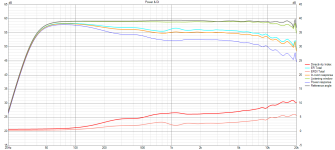I'm not sure, simulated and measured data seems to agree to each other and within that context the results are as posted. I'm not sure what the wavefronts are, and what is their contribution. Also my data sample is small, so hoping others had some data to compare with. mark100 already seems to agree so there is one.
tmuikku, I've spent countless hours measuring delays' effect on multi-way polars.
(Notice the spinorama under the big synergy, to go with the multi-mic mast)
Using the mouth as POR (point of rotation) has always made for a mess.
I choose the compression driver's acoustic center as the reference POR, such that its measured ToF remains as constant as possible under rotation.
Then the other sections ToF's vary under rotation, not having their acoustic centers be the POR.....
but such is life, and becomes time for juggling fixed delays to find best compromise.
Back on topic.Here we go, I forgot I already have one -
View attachment 1373652
0° and 40°:
View attachment 1373654View attachment 1373653
OK, almost 🙂
Probably not worth the (slightly) more uneven response, but it's still no issue with a DSP.
This is probably as close to an actual 800-20k constant-directivity horn I can get.
You have a relatively small peak at a relatively high frequency here for a BMS driver. Maybe you just got a great one or is it possible your long horn does some influence here?
The behaviour itself is really promising. When knowing that before I did my home cinema speakers ...
What would you use as a smaller horn, combining with a 10" TMT? Did you ever thought about an unsymmetrical horn to get the midrange closer to the acoustic center? I still have the prototype of an unsymmetrical waveguide for T25B here (oval at one side to get closer to the TMT, round for the rest of the radius) but no time for testing ...
Question is a bit abstract. I have been arguing for the following:
- constant horizontal directivity in combination with a wide radiation pattern is desirable for a bigger stereo image.
- narrowing vertical directivity in combination with constant horizontal directivity is desirable for sound power tonal balance.
- sloping the direct sound to adjust for too much high frequency sound power is very limited as a solution, as the direct sound will quickly sound dull. We dominantly perceive ON/LW direct sound and consider it right when it is linear.
For the devices that you have been designing so far, the sloping DI is this probably preferable, as the pattern as such is narrow and will not present a big stereo image anyway.
- constant horizontal directivity in combination with a wide radiation pattern is desirable for a bigger stereo image.
- narrowing vertical directivity in combination with constant horizontal directivity is desirable for sound power tonal balance.
- sloping the direct sound to adjust for too much high frequency sound power is very limited as a solution, as the direct sound will quickly sound dull. We dominantly perceive ON/LW direct sound and consider it right when it is linear.
For the devices that you have been designing so far, the sloping DI is this probably preferable, as the pattern as such is narrow and will not present a big stereo image anyway.
There's one trick I see seldom mentioned - with a narrow(ish) beam of sound and a strong toe-in (allowed by the constant directivity), you can send the sound from the left speaker to the right ear via a strong reflection off the right wall, and vice versa. This greatly enhances spatial qualities without affecting anything else.
I can see the appeal. The only problem is that such devices tend to be really big, otherwise it creates more problems than it solves, IMO.- narrowing vertical directivity in combination with constant horizontal directivity is desirable for sound power tonal balance.
That has been my experience as well, it may not be easy to "tune" such system. That's why I question this approach a bit.- sloping the direct sound to adjust for too much high frequency sound power is very limited as a solution, as the direct sound will quickly sound dull.
Last edited:
I don't know if it made sense to describe it, but in case it's useful.
Before A520G2 I've used RCF 950 - 90x50 constant directivity horn ~30x30 cm.

Of course it's not just a directivity comparison, the 950 horn uses diffraction, it's smaller, has a wider horizontal directivity, etc. But if I think back, the key differences I noted (during the comparison the crossover was around 500-600 Hz, equalization to an identical curve from an array of averaged measurements on the couch, bass boxes the same):
+Noticeably more clarity with 520
+Less room aftertouch in midrange frequencies subjectively, clearer behavior around 500-1.5 kHz on the spectrogram
+/- The perception of frequency balance with the same room curve was slightly different, the treble level needs to be adjusted for a similar feel
- The 950 horn provided a more consistent sense of sound when moving around the couch, the difference isn't drastic, but it's pretty noticeable
+/- In my subjective perception, the 520's give a more accurate perception of the scene. My friend said that he felt the 950 gave a better sense of 3D effect in my room (although this was not about a direct comparison, but a comparison with another system and another mid bass design from memory). And he uses a 950 in his system too, perhaps it's more familiar to him
It's hard for me to draw conclusions. I seem to prefer narrower directivity, although it would be interesting to hear a larger 90 degree constant directivity horn in my room, size does matter. For the same reason, I'd be interested to hear an even larger G2 horn 🙂 Both horns are of good enough for me, the 520 is still in the system.
Before A520G2 I've used RCF 950 - 90x50 constant directivity horn ~30x30 cm.
Of course it's not just a directivity comparison, the 950 horn uses diffraction, it's smaller, has a wider horizontal directivity, etc. But if I think back, the key differences I noted (during the comparison the crossover was around 500-600 Hz, equalization to an identical curve from an array of averaged measurements on the couch, bass boxes the same):
+Noticeably more clarity with 520
+Less room aftertouch in midrange frequencies subjectively, clearer behavior around 500-1.5 kHz on the spectrogram
+/- The perception of frequency balance with the same room curve was slightly different, the treble level needs to be adjusted for a similar feel
- The 950 horn provided a more consistent sense of sound when moving around the couch, the difference isn't drastic, but it's pretty noticeable
+/- In my subjective perception, the 520's give a more accurate perception of the scene. My friend said that he felt the 950 gave a better sense of 3D effect in my room (although this was not about a direct comparison, but a comparison with another system and another mid bass design from memory). And he uses a 950 in his system too, perhaps it's more familiar to him
It's hard for me to draw conclusions. I seem to prefer narrower directivity, although it would be interesting to hear a larger 90 degree constant directivity horn in my room, size does matter. For the same reason, I'd be interested to hear an even larger G2 horn 🙂 Both horns are of good enough for me, the 520 is still in the system.
Hi, this seems awfully lot difference in listening distance in relation to directivity and room acoustics, which auditory system state. If one wants better scene with any speakers in amy room, shrink listening triangle size. Easiest way is to move the chair forward, enough so that you perceive the scene better. David Griesinger Auditory Proximity and Limit of Localization Distance stuff 🙂+/- In my subjective perception, the 520's give a more accurate perception of the scene. My friend said that he felt the 950 gave a better sense of 3D effect in my room (although this was not about a direct comparison, but a comparison with another system and another mid bass design from memory). And he uses a 950 in his system too, perhaps it's more familiar to him
I think that is cruzial stuff to be able to optimize waveguide, the whole system, for particular application is to know auditory system affects sound and then explore with that ehat you like, hownthe room sounds, and what directivity needs to be to best suit what you think it needs to be.
Well, yes... but no. 🙂If one wants better scene with any speakers in amy room, shrink listening triangle size.
It's like watching a movie on macbook's retina or on a not so advanced full-hd projector. I can't remember the last time I watched a movie on my laptop.
As for the flat/non-flat DI discussion, the question is simple - is better A or B? 🙂
A)
View attachment 1374093
B)
View attachment 1374094
I would also go for B.
One of my experiences with directivity at high frequencies comes from HiFi ring radiators. I had a pretty nice done monitor with ring radiator tweeter, these rise in directivity >8-10kHz. When the sound was right at close listening distances it was dulll in the room. When it was right in the room it was too much at close distance. With a tweeter like T25A you have an incredible stable and wide sound reproduction area, it feels unreal to hear the complete spectrum when standing wide off axis. But of course, your room should be more controlled for wide radiation.
Here we decide between linear narrow or getting more narrow with frequency. I would opt for an even sounding listening zone.
In my old apartment, there was a time I listened to stereo loudspeakers (with 90° CD waveguides) completely indirectly, via reflections, with the speakers facing the walls at some angles, and it was great. So forgiving it was 🙂 and the sound stage was huge.
Aha, exactly! you prefer being further away and enjoy local room effects to sound, which you can now utilize to your advantage. Just be aware clarity and localization will never be as accurate as closer up, and the retina stuff might relate to poor envelopment which directivity and toe-in play critical role. Have you tried optimizing this ever?Well, yes... but no. 🙂
It's like watching a movie on macbook's retina or on a not so advanced full-hd projector. I can't remember the last time I watched a movie on my laptop.
Some people want one, some the other, and there is no reason to go just one because one can choose at will if you listen where your auditory system switches between the two. I'm optimizing for both. Anyway, key thing is to communicate this stuff, otherwise it's confusing what to optimize for if people try to optimize for the other thing, and no one knowing what everyone is talking about 😀
Last edited:
It's not what I prefer. The scale of perception depends on the size of the stereo triangle, it's easy to hear this in a mastering room where there are no reflections. Near-field and far-field monitors sound completely different. A reasonable amount of reflections can certainly be useful, no argument with that.and enjoy local room effects to sound
Believe it or not but the T34A provides even wider beamwidth with the right (very shallow) waveguide.With a tweeter like T25A you have an incredible stable and wide sound reproduction area, it feels unreal to hear the complete spectrum when standing wide off axis.
It's because its diaphragm is taller, which happens to be the major factor.
As for the flat/non-flat DI discussion, the question is simple - is better A or B? 🙂
A)
View attachment 1374093
B)
View attachment 1374094
B ''looks right", but I think it will be perceived as too bright. If we EQ B such that the first-arrival sound is gently downward-sloping by the right amount then I think B would sound superb.
That being said, A is still really, really good.
There's one trick I see seldom mentioned - with a narrow(ish) beam of sound and a strong toe-in (allowed by the constant directivity), you can send the sound from the left speaker to the right ear via a strong reflection off the right wall, and vice versa. This greatly enhances spatial qualities without affecting anything else.
Agreed.
I have been using this set-up geometry for about twenty years. With strong toe-in such that the speaker axes are criss-crossing in front of the listening position, the listener is maybe 15 to 20 degrees off-axis. So the direct sound from the speaker is the 15 to 20 degrees off-axis sound, rather than the speaker's on-axis sound. This results in slightly less high-frequency energy in the first-arrival sound, and correspondingly less spectral discrepancy between the direct and reflected sound (with no change to the power response). I think this is desirable. Quoting Floyd Toole:
If the spectra of the direct and reflected sounds are significantly different, the reflections are likely to be more noticeable, from subtle timbral effects up to a premature breakdown of the precedence effect...
His use of the word "significantly" implies that there is a threshold for the spectral difference between the direct and reflected sounds beyond which timbre is degraded. I don't know what the threshold is, so it is only my opinion that minimizing the spectral difference matters.
In my old apartment, there was a time I listened to stereo loudspeakers (with 90° CD waveguides) completely indirectly, via reflections, with the speakers facing the walls at some angles, and it was great. So forgiving it was 🙂 and the sound stage was huge.
VERY creative! I believe you. At one time I manufactured controlled-pattern bipolar speakers, which unfortunately took up a lot of space within the room, but in some ways they presented a desirable combination of attributes.
Last edited:
I can see the appeal. The only problem is that such devices tend to be really big, otherwise it creates more problems than it solves, IMO.
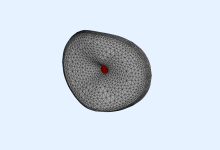
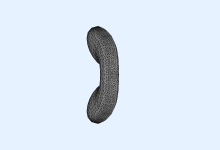
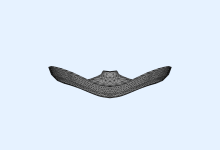
I am failing to find the time for designing a more refined device from Ath, but I consider this approach the silver bullet.
If more effort was invested, maybe even developing the tools to make certain shapes attainable, many issues can be solved. In the example, however, as you can see resonances are pronounced. I am impatient to work the complex form currently. I will share the code the other day.
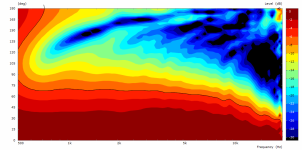
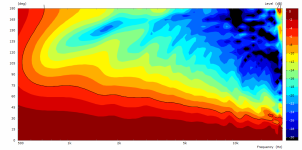
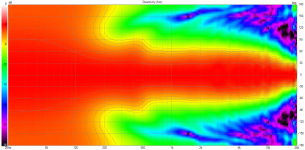
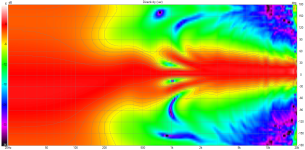
The free standing waveguide option in ath allows to combine two different profile depths already, to some extend. I do not remember which parameter again enables the bending-forward of the vertical section, this helps to extend pattern control for the vertical angles. With 'normal' asymmetric devices, we usually observe the issue in the vertical sonograms that at a frequency well within the intended passband of the compression driver, between 2 and 4 kHz, a pattern flip occurs due to loss of control. This is caused by the short length of the walls, which is not an issue for the outdoor application as a PA speaker, but very much so in rooms.
There is probably more solutions for increasing the vertical control capability. I have previously shown the waveguide of the GGNTKT M1, where the shallow horizontal profile is placed withtin the deeper vertical profile, using sort of a 'slot feature approach. From my understanding, this too offers uncomprised vertical control, while simultaneously allowing for a wide and constant horizontal pattern.
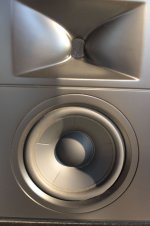
Attachments
B) but the top meed to be absolutely clean and low dist - the least of sibilance etc and its a no-no... I think this is one good thing - it forces you to get 1-20k perfect or...
//
//
Could it be that there is a similar character to bigger rooms, and this is perceived as a decongestion of boundaries? When you think about transients blurring in the terms of reflections versus perception. The longer cycle times of LF alleviate the perception of such, right? Would it be crazy to say that simply the opposite thing that happens as we move towards the upper spectrum, is increasingly undesirable? One thing that remains constant is boundary distance, thus reflective timing. These reflections should become more and more noticeable as source frequency increases.It seems that we, as listeneres, prefer flat direct sound but not really flat total in-room power (which would lead to a slightly rising DI). But why?
Last edited:
I question the prevailing wisdom of prioritizing a flat direct sound, rather than prioritizing minimizing the spectral discrepancy between the direct and reflected sounds.
What box lol... one thing that you can rely on is that civilization via technology has been advancing much faster than any type of human mutations that I at least, know about.leaving it up to those who can extrapolate and "think outside the box"
You can still trace back, plenty of human behavior/physiology/psychology to character developed in the natural world.
Theres plenty of natural spaces where the reflective power response is going to be tapering off, moving towards HF....
One of the biggest perks of my job is working outside, weather permitting. People in offices want the corner room with all the windows so they say... so when stuck inside we desire to see as much of outside as possible. The removal of the perception of boundaries. Would it be far fetched to think that we have the same desires, acoustically?
Outside is nothing like being in an anechoic chamber. Its also nothing like being in a small room.
Last edited:
The HF reflections are certaily more favourable, almost universally perceived as beneficial if delayed enough (that's for what you need the narrow directivity - to have enough of the late ones without the (very) early ones). In a room the situations at LF and HF are very different in terms of perception, you know this. And there are no "LF transients", that's all MF/HF stuff.When you think about transients blurring in the terms of reflections versus perception. The longer cycle times of LF alleviate the perception of such, right? Would it be crazy to say that simply the opposite thing that happens as we move towards the upper spectrum, is increasingly undesirable? One thing that remains constant is boundary distance, thus reflective timing. These reflections should become more and more noticeable as source frequency increases.
Last edited:
- Home
- Loudspeakers
- Multi-Way
- Acoustic Horn Design – The Easy Way (Ath4)
